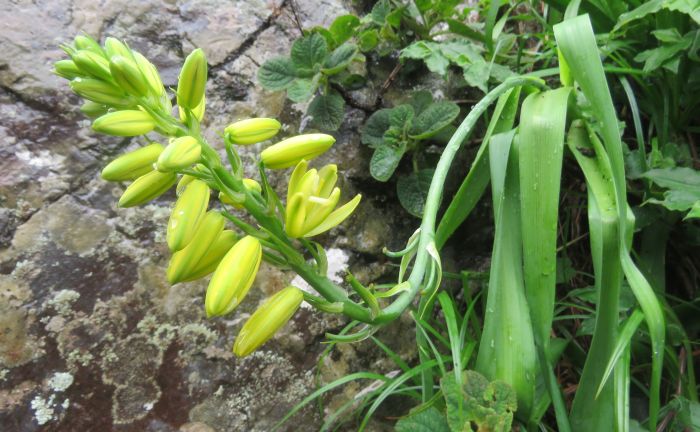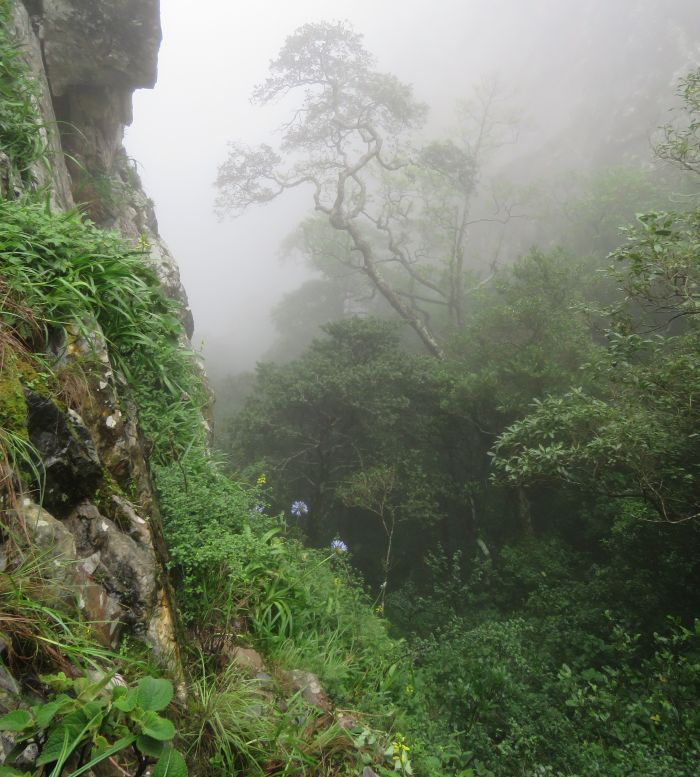Albuca heydenrychii
Albuca heydenrychii Van Jaarsv.
Family: Hyacinthaceae
Common names: yellow cliff-albuca (Eng.); krans-slymstok (Afr.)
Introduction
Albuca heydenrychii is a cliff-dwelling, bulbous plant with soft, flaccid leaves up to 1 m long and a raceme of bright yellow flowers in midsummer. It comes from the northeastern escarpment in the Limpopo Province, South Africa. Plants are easily grown in humus-rich, very well-drained soil and do well in containers, but are best in a cool, summer-rainfall climate, in dappled shade. Even when it is not growing on a cliff, the leaves and inflorescence becoming drooping.

Figure 1. Albuca heydenrychii in flower in habitat on a sandstone cliff together with Plectranthus rupropunctatus.
Description
Description
The plants are winter-deciduous bulbs. The bulb is solitary or dividing to form small clusters of up to 3 heads. Bulb broadly egg-shaped, 40–50 × 45–55 mm, the basal plate 20 mm in diameter, with fleshy bulb scales, the outer withering and becoming grey and papery. The roots are fleshy, white, up to 1.0–1.5 mm in diameter. The leaves 2 to 5 per bulb, linear, flat becoming rounded (subterete), about 1–1.2 m long and 60–80 mm wide, in an basal rosette, drooping to spreading, green, slightly fleshy, flaccid, ending in a sharp soft point at the tip. The leaves are shallowly channelled with 35 striations, each 1–3 mm apart, hairless. The margin is entire, whitish and transparent.

Figure 2. Close-up of the bulb of Albuca heydenrychii on a sandstone cliff.
The inflorescence is spreading to pendent, 70–400 mm long; scape often with an s-bend, the inflorescence stalk 5–8 mm in diameter at base and the racemes are ascending, 50–300 mm long, bearing triangular, acuminate, membranaceous bracts. The flowers are spreading, 18–20 mm long, yellow. The outer tepals linear-ovate, 16–18 × 5 mm, yellow with green middle portion, the ends somewhat hooded. The inner tepals egg-shaped. The stamens with filaments 15 mm long, 2 mm in diameter at base; inner filaments with a constriction in lower third, the anthers of inner filaments 2 × 1 mm and the anthers of the outer filaments 4–5 × 1.5 mm. The pollen is yellow. The ovary (female part) green, with 3 distinct crests, 4 mm long, 3.5 mm in diameter, with a yellow style, 3-angular. The capsule is egg-shaped (ovoid), acute 15 × 16 mm. The seed is 7 × 3 mm, black, flattened, somewhat half lunar in shape. Flowering time is in summer.
Conservation Status
Status
Albuca heydenrychii, although rare, localized and known only from a solitary site, it is difficult to reach, with some plants growing on inaccessible ledges in a very remote part of the Limpopo Province and thus very well protected by its habitat.
Distribution and habitat
Distribution description
Albuca heydenrychii is only known from south-facing cliffs of the east-facing escarpment, growing near Thabakgolo in the Limpopo Drakensberg, south of Tzaneen. The plants occur on the margin of Northern Mistbelt Forest and Northern Escarpment Quartzite Sourveld (Mucina & Rutherford 2006). The plants grow on the upper cliff faces at an altitude of about 1 400 m, with frequent mist. Rainfall is high and about 700–1 000 mm per annum and from spring to autumn with moderate warm summer temperatures. Winters are cooler but without frost. The geology consists of nutrient-poor quartzitic sandstone (Black Reef Group, Transvaal Supergroup). Associated bulbs and succulents observed in the habitat, are Agapanthus inapertus, Tulbaghia simmleri, Aloe arborescens and A. spicata, Crassula sarcocaulis and C. pellucida subsp. alsinoides. The habitat is also fringed and partially shaded by Afrotemperate Forest, with trees and shrubs such as Combretum kraussii, Faurea rochetiana, Hemizygia rugosifolia, Maesa lanceolata, Protorhus longifolia, Rapanea melanophloeos, Podocarpus latifolius, Psychotria capensis, Schefflera umbellifera and Vaccinium exul. Other perennials observed in its habitat are Helichrysum wilmsii, Plectranthus rubropunctatus, Coleus calycina and Streptocarpus cyaneus.

Figure 3. Albuca heydenrychii in habitat with Reuben Heydenrych who first discovered this new species and in whose honour it is named.
Derivation of name and historical aspects
History
Albuca heydenrychii was named by the author in Flowering Plants of Africa in 2019 (Van Jaarsveld & Visagie 2019) from specimens gathered by Reuben Heydenrych on 11 January 2008. Reuben is an ecologist and keen hiker from Pretoria and whilst on a hike on the Drakensberg Escarpment Mountains near Thabakgolo (Limpopo Province), the bright yellow racemes of a plant on the cliff attracted his attention. Upon investigation, specimens for the National Herbarium at Pretoria (SANBI) were gathered, as well as a few bulbs which he grew at his house in Pretoria. These were noticed by a botanist friend, Pieter Winter from SANBI, Pretoria, who later informed the author. Reuben provided the author with some seed and bulbs, which were grown at Babylonstoren Farm. This plant flowered in December 2018, and was illustrated by the accomplished botanical artist Marieta Visagie from Stellenbosch.
A subsequent expedition was then arranged in January 2019, together with Reuben Heydenrych, Paul Kruger and Jaco Lategan, assisting the author to investigate the plant in its cliff habitat. Reuben took us to its habitat and plants were found north of Magokolo Peak along the main watershed of the northern Drakensberg, while they were in flower.
The genus Albuca was established by Carl Linnaeus in his second edition of Species plantarum in 1762. It currently contains more than a 100 species (Manning & Condy 2011) and the last comprehensive revision was by Baker in Flora capensis in 1897. The genus name, Albuca, is derived from the Latin word albus, meaning ‘white’, in reference to the white flowers of most of the species within the genus (Clarke & Charters 2016). Albuca is mainly confined to Africa and the Arabian Peninsula. They vary from dwarf bulbs with a solitary leaf a few cm high, such as A. unifoliata, to the large, robust, white-flowering Albuca nelsonii, that is popular in gardens. Most of the species are confined to the winter rainfall parts of South Africa. Plants from the winter rainfall region are summer-deciduous and the opposite is true for most of the summer rainfall species. Some, especially from the southeastern Cape, are evergreen. Flowers of Albuca vary from white to yellow, some ascending or spreading and others pendent.
Albuca heydenrychii belongs to the section Pallastema, subgenus Albuca (Manning et al. 2009), immediately recognised by their unspecialised, spreading, weakly regular flowers, the female part (ovaries) distinctly crested, with slender styles. Only 3 species of Pallastema (established by Baker in 1873), all from the summer rainfall region, are known from southern Africa, namely A. abyssinica Jacq., A. amboensis and A. heydenrychii. These 3 become deciduous in winter. The floral presentation, shape and yellow colour is similar in all species. Of these 3 species, A. heydenrychii differs in habit and general form. The long, soft, flaccid, drooping leaves up to 1 200 mm long and up to 80 mm wide, immediately separates it from the other two. The curved inflorescence is also a distinct characteristic, which is maintained in cultivation.
Ecology
Ecology
The bulbs of Albuca heydenrychii grow relatively shallowly among quartzitic sandstone rocks, firmly anchored by its roots. The long, relatively broad leaves grow at first ascending spreading, becoming drooping, and are adapted to the shady habitat. The flaccid texture allows for its vertical to near vertical habitat, becoming drooping. The inflorescence also droops, but, as with many other cliff dwellers, the racemes tend to become ascending at the tips, resulting in the curved inflorescence. During the dry period, the leaves become deciduous and the bulb becomes dormant. With the onset of rain in spring, the bright green leaves appear. The bright yellow flowers are horizontally projected, we can assume they attract flying insects (probably a beetle) during its flowering period, when pollination is accomplished. After pollination the fruiting capsule enlarges and is held in an ascending position. When ripe, the capsule splits at the valves and flattened, wind-dispersed seeds are released and are scattered by strong winds on the cliff face. Cliffs provide shelter for many plants and smaller animals against larger herbivores and other predators.
Of the southern African species, about 12 species of Albuca are known from cliff faces or grow on steep slopes. These cliff-dwellers include, A. batteniana, A. buffelspoortensis, A. cremnophila, A. crudenii, A. deaconii, A. fastigiata, A. heydenrychii, A. kirstenii, A. lebaensis, A. tenuifolia, A. thermarum and A. tenuifolia. Albuca shawii is widespread in the summer rainfall regions (Grassland and Savanna Biomes), also with yellow racemes, but not always confined to cliffs. The flowers are much smaller and it belongs to section Falconera. Most of these cliff-dwelling bulbs have restricted distributions.

Figure 4. Albuca heydenrychii in habitat, growing on a sandstone cliff face together with Agapanthus inapertus and Tulbaghia simmleri. Note the mist which provides extra precipitation.
Uses
Use
It is not known whether this particular species is used medicinally.
Growing Albuca heydenrychii
Grow
Albuca heydenrychii is an attractive plant, best suited for cool and moist Highveld gardens. It grows best in a sheltered position, such as a shady part of the garden, or in a container on a shady stoep (Van Jaarsveld 2010). Plants should grow well on steep, south-facing embankments, in partial shade. They grow relatively fast. Outside of its habitat, it is best grown in a greenhouse where the climate can be controlled. The substrate should be well-drained, sandy, slightly acidic soil to which compost is added. It can also be fed with an organic fertilizer. The plant should also grow well in hanging baskets where the leaves will become drooping.
Plants are easily propagated from seed sown in spring or summer or by division during the dry winter season. Sow seed in a container filled with a sandy medium that provides sufficient drainage. Cover the seed with a thin layer of gravel or sand and place in a warm, shady position. Germination is usually within 3 weeks. Young plants grow rapidly and can be transplanted into containers when large enough to handle. Keep the plants dry in winter (May to August).
References
- Baker, J.G. 1873. Revision of the genera and species of Scilleae and Chlorogaleae. Journal of the Linnean Society, Botany 13: 209–292.
- Baker, J.G. 1897. Liliaceae. In W.T. Thiselton-Dyer, Flora capensis 6: 253–528. Reeve, London.
- Christenhusz, M.J.M., Fay, M.F. & Chase, M.W. 2017. Plants of the World, an illustrated Encyclopedia of vascular plants. Kew Publishing, Royal Botanic Gardens, Kew.
- Clarke, H. & Charters, M. 2016. The illustrated dictionary of southern African plant names. Flora & Fauna Publications Trust, Jacana, Johannesburg.
- Heydenrych, R. 2018. A field guide to Magaliesberg trees. BK Publishing, Pretoria.
- Linnaeus, C. 1762. Species plantarum edn. 2, vol. 1. Salvius, Stokholm.
- Manning, J. & Condy, G. 2011. Albuca spiralis. Plate 2265. Flowering Plants of Africa. 62: 30–35.
- Manning, J.C., Forest, F., Devey, D.S., Fay, M.F. & Goldblatt, P. 2009. A molecular phylogeny and a revised classification of Ornithogaloideae (Hyacinthaceae) based on an analysis of four plastid DNA regions. TAXON 58(1):1-107.
- Mucina, L. & Rutherford, M.C. (eds) 2006. The vegetation of South Africa, Lesotho and Swaziland. Strelitzia 19. South African National Biodiversity Institute, Pretoria.
- Van Jaarsveld, E.J. 2010. Waterwise gardening in South Africa and Namibia. Struik, Cape Town.
- Van Jaarsveld, E.J. & Visagie, M. 2019. Albuca heydenrychii. Flowering Plants of Africa 66: 31–36, t. 2344.
Credits
Ernst van Jaarsveld
Kirstenbosch National Botanical Garden (Retired 2015)
Babylonstoren Farm
Extraordinary senior lecturer and researcher,
Department of Biodiversity and Conservation, University of the Western Cape
July 2020
Plant Attributes:
Plant Type: Bulb
SA Distribution: Limpopo
Soil type: Sandy, Loam
Flowering season: Early Summer
PH: Acid
Flower colour: Yellow
Aspect: Shade, Morning Sun (Semi Shade), Afternoon Sun (Semi Shade)
Gardening skill: Challenging
Special Features:
Horticultural zones







Rate this article
Article well written and informative
Rate this plant
Is this an interesting plant?
Login to add your Comment
Back to topNot registered yet? Click here to register.